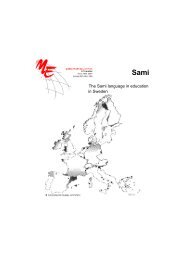Multilingual Early Language Transmission (MELT) - Mercator ...
Multilingual Early Language Transmission (MELT) - Mercator ...
Multilingual Early Language Transmission (MELT) - Mercator ...
You also want an ePaper? Increase the reach of your titles
YUMPU automatically turns print PDFs into web optimized ePapers that Google loves.
6.3 <strong>Multilingual</strong> <strong>Early</strong> <strong>Language</strong> <strong>Transmission</strong> in smaller state and regional &<br />
minority languages<br />
Depending on the strength and vitality of the language concerned, the political<br />
circumstances and practical possibilities, as well as the ambitions of parents and authorities,<br />
various models of upbringing and teaching are applied. Within the <strong>MELT</strong> project a range of<br />
models is displayed and discussed. The total immersion method is applied at the day care<br />
centres and pre-school provisions of the Swedish-speaking community in Finland as well as<br />
in Wales. They have the policy and the strong belief that the total immersion approach in<br />
the minority language will foster bilingual or multilingual individuals, and that within these<br />
structures the minority languages will have better chances of maintenance. Note that in<br />
these regions “immersion” also refers to mother-tongue education in minority languages.<br />
The experiences within Finland and Wales show that in those linguistic situations children<br />
from majority language speaking families benefit more from bilingual provisions and<br />
structures than the children from minority speaking families. In other words: through<br />
immersion most of the Swedish-speaking children in Finland become bi- or multilingual,<br />
while the Finnish children tend to stay more unilingual. The same holds for Welsh speaking<br />
children within Wales. Those children are living in the prosperous situation of having a<br />
chance to continue their schooling at primary and secondary education through the medium<br />
of Swedish respectively Welsh.<br />
In Friesland and in Brittany on the contrary, the minority languages are less vital in terms of<br />
language prestige, their position and function in education, and with respect to language use<br />
in public life and in the media. Therefore, in Brittany and in Friesland, it is much harder to<br />
implement structures and provisions which apply total immersion, although experts agree<br />
that also in those regions the immersion approach would be beneficial for the children<br />
involved. In these regions, more often part-time immersion or two-way immersion is<br />
applied: “in one-way immersion, some of the teaching time is in the target language. In twoway<br />
immersion, two language groups learn each other’s language by working for some of<br />
the pre-primary day in one language and for the rest of the day in the other” (<strong>Language</strong><br />
Learning at Pre-primary school level 2011, p. 15).<br />
The intention is that children in Friesland become bilingually fluent in Frisian and Dutch, and<br />
preferably trilingual with respect to English. The concept of trilingual schooling has been<br />
developed over the last decade, and has proven to be successful at a growing number of<br />
primary schools. Bilingual education with Frisian as a subject and medium of instruction for<br />
one day or half a day per week and English as a subject only, is widespread throughout<br />
Friesland.<br />
In Brittany the main aim of the introduction of Breton in pre-school provisions is to raise and<br />
increase among parents and grand-parents, peers and practitioners the awareness of the<br />
cultural value of Breton. The <strong>MELT</strong> project itself contributes greatly to the further<br />
development of tools for the purpose of the promotions of awareness among parents,<br />
practitioners and authorities.<br />
In all four participating regions, and indeed in all European regions with a minority language,<br />
the real challenge is the continuity of learning and teaching in and of the minority language,<br />
starting from pre-primary provisions through primary schooling to secondary education, as<br />
well as in vocational training. It is hard to define different chapters within the curriculum for<br />
majority respectively minority language speakers, including different attainment targets,<br />
time tables and assessment procedures. The ideal situation would be that each individual<br />
81



